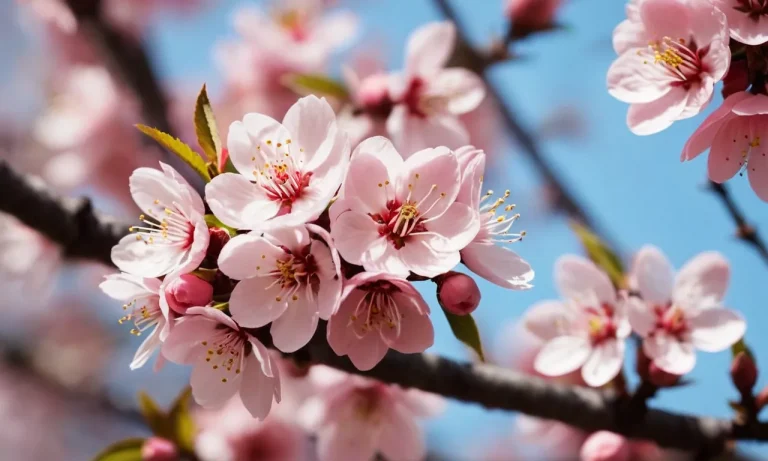The concept of a tree of life, a mystical tree that connects the heavens, the earth, and the underworld, appears in various religions and mythologies around the world. If you’re short on time, here’s a quick answer to your question: The tree of life is an ancient spiritual symbol that represents inner wisdom, eternity, interconnection with all of life, spiritual growth, and the union between God and creation.
In this comprehensive guide, we will explore the origins of the tree of life symbol, its appearances throughout various faith traditions and cultures, its spiritual meaning and significance, and how understanding this rich symbol can provide deeper wisdom into our personal spiritual paths.
Origins and Early Symbolic Representations of the Tree of Life
The tree as a sacred symbol in ancient traditions and cultures
Trees have long held mystical and religious importance in cultures around the world. Many ancient peoples viewed trees as sacred entities representing life, wisdom, strength, and endurance. The tree was widely revered as a living bridge between the heavens and earth, with its roots in the underworld and branches reaching to the sky.
Some researchers believe the concept of a tree symbolizing life originated in Indian spiritual traditions which later spread to Persia, Mesopotamia, and into Western culture. The Indus Valley Civilization, dating back to 3300 BCE, has yielded images of trees along with human and animal figures, perhaps signifying the interconnection of the human, natural, and divine realms.
The early Aryans also regarded the soma plant – possibly ephedra – as an elixir of life, and symbolized this through tree imagery in sacred Hindu texts called the Vedas.
Across Mesoamerican, African, and Asian spiritual cosmologies, we find the axis mundi motif of a great world tree or pillar reaching from the underworld, ascending through the earthly realm, and into the sky – grounding humans in the cycles of life, death, and renewal that connect all beings.
This reflects the understanding in ancient belief systems that trees, along with mountains, springs, and caves, can serve as portals bridging mortal and immortal worlds.
Tree worship and tree of life motifs in ancient Egypt, Mesopotamia, and Indus Valley civilizations
In ancient Egypt, trees held particular religious import, with sycamores considered manifestations of sky goddess Nut who nurtured the dead with food and water. Sycamore trees lined processional routes to honor both the living and deceased pharaohs.
Egyptians also associated the djet or persea tree with life after death and burial rites. On funeral stelae lining tombs, carvings depicted the tree and associated deities to aid the deceased’s journey into the afterlife.
In the Mesopotamian Epic of Gilgamesh, the hero traveled across waters to reach the garden paradise where the plant of life – possibly a grapevine or date palm – grew. Gilgamesh failed to obtain the plant as a gift of immortality for humankind, underscoring the fleeting life of mortals ruled by capricious gods.
This theme endured throughout ancient Middle Eastern cultures, with the Babylonians revering the huluppu or willow tree and depicting gods presiding over a tree of life, shown on boundary stones called kudurrus.
In the Indus Valley, excavations unearthed bronze figures positioned yogically around tree-like poles, hinting at a ritual or meditative relationship to trees by early South Asian peoples. Seals and tablets also revealed depictions of animals and deities alongside sacred tree imagery, emphasizing the interconnections of life as viewed in Hindu cosmology.
The tree of life in ancient myths and world religions
The tree of life concept appears in the myths and scriptures of several world religions and cultures, often representing symbolic themes of immortality, divine refuge and sustenance, or humankind’s relationship to the spiritual and natural worlds.
- The ancient Norse Yggdrasil or world ash tree connected different realms through its roots and branches.
- In Daoism, the penglai or immortal islands were home to magic trees bearing the elixir of everlasting life.
- The Chinese Goddess of Mercy or Kuan Yin often appears emerging from a willow tree, signifying protection.
- Buddhism’s enlightenment tree signifies refuge and spiritual liberation.
- Judeo-Christian scriptures describe the tree of life and knowledge in humanity’s primordial garden paradise before earthly exile.
Thus, we find similar themes around sacred trees and humanity’s relationship to eternal life or to divine realms spanning diverse ancient cultures and faiths worldwide. Trees remain powerful universal symbols reminding us of our deep spiritual interconnection with the living world.
The Tree of Life Symbol in Judaism and Kabbalah
The tree of life in the Garden of Eden
In the biblical Book of Genesis, the tree of life is mentioned in the Garden of Eden, along with the tree of knowledge of good and evil. God places cherubim and a flaming sword to guard the way to the tree of life after Adam and Eve eat fruit from the tree of knowledge and are expelled from Eden.
The tree of life in the Hebrew Bible
The tree of life is mentioned in several other books of the Hebrew Bible as well, including Proverbs, where wisdom is compared to a tree of life. Overall in the Hebrew Bible, the tree of life represents blessings, eternal life, nourishment, and spiritual strength.
The 10 spheres of the Kabbalistic tree of life and their spiritual meaning
The Kabbalistic tree of life developed during the 16th-century features 10 spheres interconnected by 22 paths. The 10 spheres, called sephirot in Hebrew, represent the following:
- Keter – The crown; Divine will
- Chokhmah – Wisdom
- Binah – Understanding
- Chesed – Mercy
- Gevurah – Strength
- Tiferet – Beauty; harmony between forces
- Netzach – Victory, eternity
- Hod – Splendor
- Yesod – Foundation
- Malkuth – Kingdom; the divine realm
Together, these 10 spheres reveal deep insights into God’s creation and the spiritual forces behind existence. Meditating on these spheres and their interconnections allows Kabbalists to better understand the divine flow from the infinite realm down through increasing levels of manifestation.
How Kabbalists use the tree of life in meditation
By visualizing the tree of life with its spheres and connecting paths, Kabbalists ground themselves with the divine presence during meditation. Starting from the top sphere of Keter, the meditator can traverse downwards through the spheres, concentrating on each sephira and channeling their unique spiritual energy.
In addition, Kabbalists also utilize specific mantras related to the names of God associated with each sphere. By intoning these mantras, they activate and align themselves with the energies represented by the sephirot.
This mystical process allows Kabbalists to achieve yet deeper states of consciousness and come nearer to perceiving the divine essence.
The Tree of Life in Christianity
Parallels between the Garden of Eden tree and the Christian cross
In the Book of Genesis, the Tree of Life was planted by God in the Garden of Eden, representing immortality, wisdom, salvation, and eternal life. Many scholars have drawn intriguing parallels between this tree and the Christian cross on which Jesus was crucified.
The cross serves as a symbol of redemption and everlasting life for those who believe in Christ.
Both the Tree of Life and the cross were made of wood and intended to reverse the curse of death brought into the world by Adam and Eve’s disobedience. Jesus’ death on the cross paid the penalty for sin, allowing redeemed humanity to once again access the Tree of Life in heaven (Revelation 22:2).
So in a real sense, Christ became our Tree of Life through his sacrificial love.
Jesus Christ represented as a tree of life
In Christian thought throughout history, Jesus has been depicted as a Tree of Life in various ways. Some church fathers like St. Bonaventure meditated extensively on the life-giving wood of both the cross and the tree in Eden as symbols of Christ.
In the 11th century, Saint Hildegard of Bingen even recorded a vision she had of the Lord appearing to her as a burning tree glowing with beautiful gemstones.
This Bible passage is also interpreted as portraying Jesus as a Tree of Life: “Blessed is the man who trusts in the Lord, whose trust is the Lord. He is like a tree planted by water, that sends out its roots by the stream, and does not fear when heat comes, for its leaves remain green, and is not anxious in the year of drought, for it does not cease to bear fruit” (Jeremiah 17:7-8).
The life-giving waters represent God’s grace to believers in Christ.
The tree of life in Christian art and architecture
In Christian architecture and art throughout history, various renderings of a Tree of Life motif represent key theological concepts. These symbolic trees are laden with fruit, showing that Christ provides nourishment and spiritual vitality to His church.
Some cathedrals like St. Lucy’s in Italy feature a striking mosaic Tree of Life on the ceiling near the altar. Chartres Cathedral in France contains multiple ornate carvings of trees in its ornate stonework, including over the central doorway.
Fabergé eggs have depicted jewel-bedecked trees of precious metals as symbols of Russia’s Orthodox heritage.
Regardless of the medium, the Tree of Life remains a signature design motif in Christian artistic traditions small and large, ancient and modern. As manifested in art, architecture, and literature, the concept takes Christians back to the very beginning in the Garden of Eden where this enduring symbol was first divinely planted to bless mankind with life.
The Tree of Life Symbol in Other Religions
The world tree Yggdrasil in Norse mythology
In Norse mythology, the concept of the Tree of Life is embodied in Yggdrasil, the giant mythological tree that connects the nine worlds in Norse cosmology. According to legend, the great ash tree Yggdrasil stands at the center of the universe, its branches and roots stretching out across all worlds (Norse-Mythology.org).
Yggdrasil serves as the life-giving force in the Norse mythos, an eternal green ash covered in moist white loam and filled with the energies and spirits of all life. Its branches extend into Asgard, home of the gods, representing the heavens.
Its roots dig deep into other worlds, symbolizing the underworlds. It represents the cycle of birth, growth, death and rebirth. The great tree is said to endure hardships, pain and instability. For example, the mythic squirrel Ratatoskr carries insults from one end of the tree to the other, while the wyrm dragon Níðhöggr gnaws at its roots.
For the ancient Norse, Yggdrasil epitomized the wonder and mysteries of nature. It reflected the interdependence of all existence – how all realms and beings influence one another. The rich mythology and symbolism of the Tree of Life in Norse culture emphasizes the deep resilience and power of nature amidst forces seeking to undermine it.
The Bodhi tree and the tree of enlightenment in Buddhism
In Buddhism, the Bodhi tree represents the Tree of Life as a source of wisdom and enlightenment. According to Buddhist texts, Siddhartha Gautama attained spiritual awakening, or Bodhi, while meditating underneath a large sacred fig tree in Bodhgaya, India around 500 BCE (LearnReligions.com).
This tree became known as the Bodhi Tree, or Tree of Awakening.
For Buddhists, the peaceful shade of the Bodhi Tree represents the cool, calm stillness of meditation. Its roots symbolize the four foundations of mindfulness – mindfulness of the body, feelings, mind, and mental qualities.
And its fruit represents the three trainings in moral conduct, meditation, and insight. Images depicting the Buddha seated under the Bodhi Tree convey meanings of wisdom, patience, protection and lasting happiness emerging from sustained meditation.
Many early Buddhist temples and monasteries in India and Southeast Asia were centered around a descendant of the original Bodhi Tree in Bodhgaya. This reflects the important role the Tree of Enlightenment plays in Buddhist spirituality as a symbol of the potential for human awakening.
The cosmic tree Kalpavriksha in Hinduism
Kalpavriksha, also known as the wish-fulfilling tree, is a sacred, mystical tree in Hinduism that is believed to represent the Tree of Life. Mentioned in Sanskrit literature, the Kalpavriksha emerges from the primal waters during the creation of the universe and is filled with the radiance of the sun and moon (Encyclopedia Britannica).
This tree is capable of granting all wishes, symbolizing abundance and fertility.
In Hindu iconography, the presence of Kalpavriksha indicates the deity’s power to grant both material and spiritual abundance to devotees. Various animals and mythological creatures are depicted around its base, representing the entirety of creation nourished by the Kalpavriksha.
The tree is said to mark the center of the universe and connects the earth with the heavens, serving as a cosmic pillar from which all realms grow.
As a cultural motif across Hindu legends and temple sculptures, the Kalpavriksha emblemizes the divine wish-fulfilling tree as the source of life, immortality and spiritual liberation. It exemplifies the boundless generosity of nature to nurture and provide for all creation.
Symbolic Meanings of the Tree of Life
The tree of life representing wisdom, knowledge and learning
The intricate root systems and tall branches of trees have long been seen as metaphors for acquiring wisdom, with the tree drawing nutrients and information from the earth through its roots and reaching skyward to receive energy from the sun and heavens (Source).
Many faith traditions including Kabbalah, Christianity, Norse mythology and Buddhism see the tree as representing the quest for spiritual enlightenment and connection with divine sources of truth.
Interconnection with nature
Trees connect the earthly realm with the skies, serving as pathways between the spiritual and material planes. Their anchoring roots symbolize our deep bond with Mother Earth, while their upward branches lift our consciousness to transcendent heights of inspiration and timeless wisdom.
The Tree of Life reminds us of the interconnectedness between all living things on our planet.
Spiritual growth and transformation
The Tree of Life represents the stages of spiritual development and transformation on the path to enlightenment. Just as a tree starts from a seed, grows strong roots, produces leaves/flowers and bears mature fruit, our souls evolve through successive phases into our highest and best versions.
The Tree of Life gives hope that no matter how wounded or downtrodden, our true divine essence waits to emerge into the light.
Eternal life and the afterlife
Many cultures depict a World Tree or Tree of Immortality as the link between temporal earthly existence and transcendent eternal life. The branches reach high into mystical realms beyond spacetime, promising that death is not the end – the soul lives on in an afterlife paradise such as heaven, nirvana or the Summerland.
The Tree of Life connects this life and the next, death and rebirth, body and spirit in an endless cycle.
The Significance of the Tree of Life Symbol in Spiritual Practice
Using the tree of life symbol for meditation and reflection
The tree of life symbol can be a powerful focal point for meditation and reflection in one’s spiritual practice. As we visualize the tree with its branches reaching high and its roots growing deep, we are reminded of the interconnectedness of all living beings.
Meditating on the tree and its cycles of growth can foster an ethical worldview of interdependence and oneness.
Some spiritual teachers guide students to visualize themselves as a tree, with feet as roots gathering nutrients from the earth, legs and torso as the trunk, arms as branches soaking in sacred energies from above, and crowns of leaves or flowers as one’s spiritual aspirations and goals.
This transforms the tree into a metaphor for different parts of one’s being.
Supporting ethical living and environmental awareness
Trees give us oxygen, prevent soil erosion, provide habitat for animals, and yield flowers, fruits, nuts and sap. As we appreciate the diverse gifts of trees, we may feel inspired to reciprocate through environmentally sustainable practices.
Seeing the interdependent web of life symbolized by a tree can motivate acts of ecological justice. For example, Wangari Maathai’s Green Belt Movement has planted over 51 million trees to reverse deforestation in Africa.
The tree thus becomes an icon of living harmoniously with all our relations in nature.
Fostering spiritual connections with faith traditions and communities
The tree of life appears in Islam, Judaism, Christianity, Hinduism, Buddhism, as well as mythologies and folklore worldwide. Even when interpreted differently, the universal tree symbol points to common values of wisdom, protection, strength and blessings.
Trees represent the Axis Mundi, or cosmic center, acting as a gateway between heaven, earth and underworld in many cultures.
In Genesis, the tree stands in the Garden of Eden signifying immortality. In Torah, Etz Chaim (“Tree of Life”) refers to the body of Jewish teachings. The Bhagavad Gita compares a steadily devoted person to an evergreen tree.
Such examples demonstrate the richness as well as common threads that trees weave through faiths.
Community tree plantings can bring people of diverse religious backgrounds together. Like the environmental activist Wangari Maathai, whose work bridges cultural divides, more interfaith tree planting ceremonies cultivate the common ground.
Conclusion
The enduring and widespread symbolic meaning of the tree of life across cultures and spiritual traditions shows how deeply rooted trees are in our collective consciousness as representations of spiritual growth, inner wisdom, interconnection, and eternity.
By taking time to meditate on this rich symbol and understand its many layers of meaning, we gain deeper insight into life’s great spiritual mysteries and our own soul’s journey of transformation.






